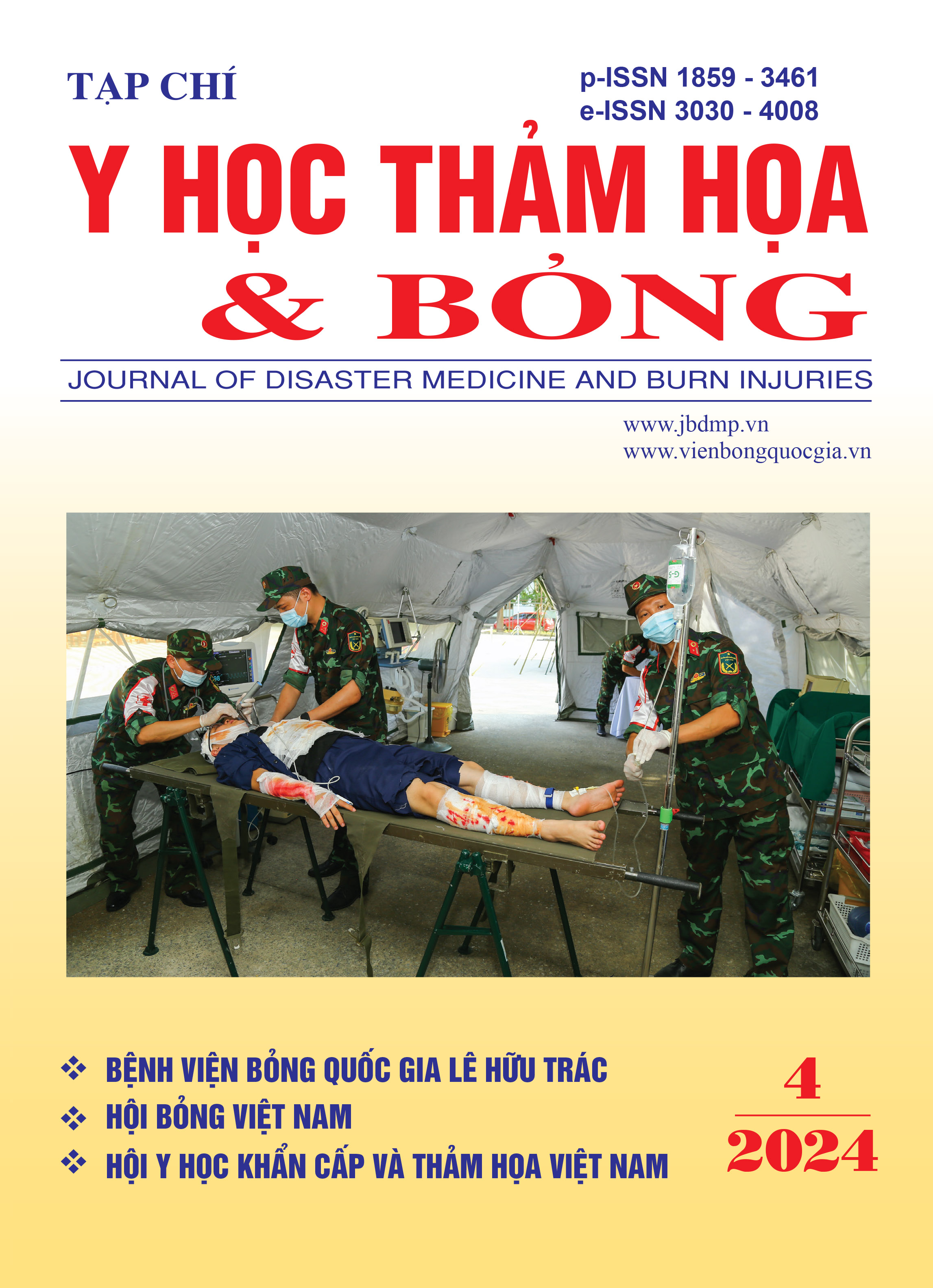Đặc điểm nồng độ TNF-α và Interleukin-6 huyết tương tại thời điểm chẩn đoán sốc nhiễm khuẩn ở bệnh nhân bỏng nặng
Nội dung chính của bài viết
Tóm tắt
Mục tiêu: Xác định đặc điểm của nồng độ TNF-α và interleukin-6 (IL-6) huyết tương ở bệnh nhân bỏng nặng tại thời điểm chẩn đoán sốc nhiễm khuẩn (SNK).
Đối tượng và phương pháp nghiên cứu: Nghiên cứu cắt ngang, mô tả tại thời điểm chẩn đoán sốc nhiễm khuản ở 54 đợt sốc nhiễm khuẩn trên 37 bệnh nhân bỏng nặng (16 - 60 tuổi), điều trị tại Khoa Hồi sức Cấp cứu, Bệnh viện Bỏng Quốc gia Lê Hữu Trác từ tháng 01/2023 đến 06/2024.
Kết quả: Tại thời điểm chẩn đoán sốc nhiễm khuẩn, điểm SOFA là 5 điểm, điểm APACHE II là 20,82 điểm, số tạng suy là 1,51 tạng; TNF-α và IL-6 huyết tương tăng cao (lần lượt là TNF-α: 20,54pg/mL (12,76 - 40,44pg/mL); IL-6: 645,45pg/mL (244,81 - 1011,28pg/mL)). TNF-α tăng mỗi 10pg/mL thì điểm SOFA có nguy cơ tăng thêm lên 0,2 lần, MAP và ScvO2 giảm thêm lần lượt 0,3 và 1,4 lần (p < 0,05); IL-6 tăng mỗi 10pg/mL thì MAP, ScvO2 có nguy cơ giảm thêm lần lượt 0,04 lần và 0,2 lần (p < 0,01); IL-6 tăng mỗi 10 pg/mL thì lactat máu động mạch có nguy cơ tăng 0,01 lần (p < 0,01).
So với các bệnh nhân sốc nhiễm khuẩn có cấy máu âm tính, các bệnh nhân SNK cấy máu dương tính có nồng độ TNF-α và IL-6 huyết tương ở thời điểm chẩn đoán SNK cao hơn đáng kể (p < 0,05). Nồng độ IL-6 huyết tương ở thời điểm chẩn đoán SNK có giá trị tiên lượng cấy máu dương tính ở mức khá. Khi kiểm định Hosmer - Lemeshow cho thấy phương trình hồi quy phù hợp với cấy máu dương tính (p > 0,05).
Kết luận: Nồng độ TNF-α và IL-6 huyết tương tăng cao ở bệnh nhân bỏng nặng tại thời điểm chẩn đoán SNK. Giá trị tiên lượng cấy máu dương tính trên bệnh nhân bỏng nặng có biến chứng SNK của nồng độ IL-6 huyết tương ở mức khá.
Chi tiết bài viết
Từ khóa
Bỏng nặng, sốc nhiễm khuẩn (SNK), TNF-α, interleukin-6
Tài liệu tham khảo
2. Mariano F., Depetris N., Malvasio V., et al. (2020). Coupled plasma filtration and adsorption for severe burn patients with septic shock and acute kidney injury treated with renal replacement therapy. Burns, 46 (1), 190-198.
3. Chung K.K., Coates E.C., Smith D.J., et al. (2017). High-volume hemofiltration in adult burn patients with septic shock and acute kidney injury: A multicenter randomized controlled trial. Critical Care, 21 (1), 1-8.
4. Bottiroli M., Monti G., Pinciroli R., et al. (2017). Prevalence and clinical significance of early high Endotoxin Activity in septic shock: An observational study. Journal of Critical Care, 41, 124-129.
5. Fink M.P. (2006) The prevention and treatment of sepsis: is interleukin-6 a drug target or a drug? Critical care medicine, 34 (3), 919-921.
6. Tischendorf J., Yagmur E., Scholten D., et al. (2007). The interleukin‐6 (IL6)-174 G/C promoter genotype is associated with the presence of septic shock and the ex vivo secretion of IL6. International journal of immunogenetics, 34 (6), 413-418.
7. Rivers E.P., Jaehne A.K., Nguyen H.B. et al. (2013). Early biomarker activity in severe sepsis and septic shock and a contemporary review of immunotherapy trials: not a time to give up, but to give it earlier. Shock, 39 (2), 127-137.
8. Gharamti A.A., Samara O., Monzon A., et al. (2022). Proinflammatory cytokines levels in sepsis and healthy volunteers, and tumor necrosis factor-alpha associated sepsis mortality: A systematic review and meta-analysis. Cytokine, 158, 156006.
9. Finnerty C.C., Herndon D.N., Chinkes D.L., et al. (2007). Serum cytokine differences in severely burned children with and without sepsis. Shock, 27 (1), 4-9.
10. Wakabayashi A., Sawada K., Nakayama M., et al. (2013). Targeting interleukin-6 receptor inhibits preterm delivery induced by inflammation. Molecular human reproduction, 19 (11), 718-726.
11. Cong S., Ma T., Di X. et al. (2021). Diagnostic value of neutrophil CD64, procalcitonin, and interleukin-6 in sepsis: a meta-analysis. BMC Infectious Diseases, 21, 1-17.
12. Gille J., Jocovic J., Kremer T., et al. (2021). The predictive role of Interleukin 6 in burn patients with positive blood cultures. International Journal of Burns and Trauma, 11 (2), 123.


